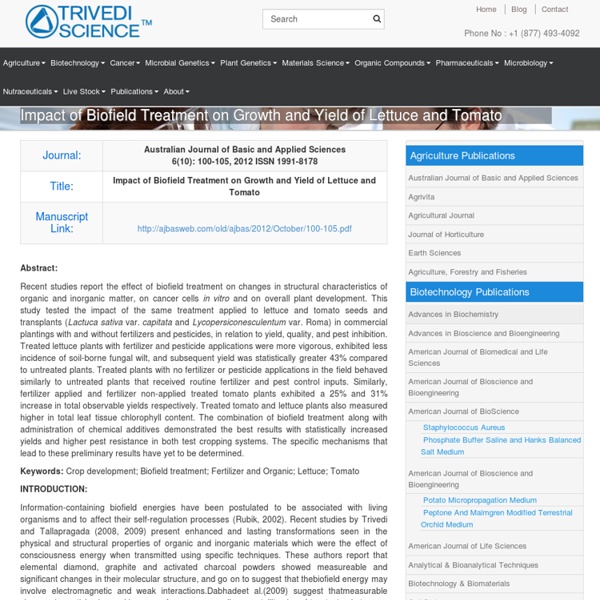Biotyping of Enteropathogenic MDR Escherichia coli Isolates
Description Study background: Multidrug resistant Escherichia coli (MDR E. coli) has become a major health concern, and failure of treatment leads to huge health burden. Aim of the present study was to determine the impact of Mr.
Research on Escherichia Coli Biochemical Characteristics
Bioeld as an energy medicine has been included in complementary and alternative medicine (CAM) therapies, and very commonly practiced in US by professional healthcare representative [11]. CAM therapies are very helpful to improve the human wellbeing and health without having any side eects.
Investigation of antimicrobial susceptibility of E. cloacae
Abstract Soybean production in Iowa USA is among the most productive for raínfed regions in the world. Despite generally having excellent soils, growing season temperatures and rainfall, soybean yields are decreased by weed interference and inadequate available soil water at key stages of crop development.
Evaluation of Phenotype and Genotype of Enterobacter Aerogenes
Abstract Enterobacter aerogenes (E. aerogenes) has been commonly described as a versatile opportunistic pathogen in hospital infections. The aim of the present work was to evaluate the impact of biofield treatment on E. aerogenes for its phenotypic and genotypic characteristics. E. aerogenes bearing ATCC 13048 (American Type Culture Collection) was procured from Bangalore Genei, in sealed pack and divided into control and treated groups. Treated group was subjected to Mr.
Experimental results of Escherichia Coli Antibiotic Sensitivity Assay
Study background: Multidrug resistant Escherichia coli (MDR E. coli) has become a major health concern, and failure of treatment leads to huge health burden. Aim of the present study was to determine the impact of Mr. Trivedi’s biofield treatment on E. coli. Methods: Four MDR clinical lab isolates (LSs) of E. coli (LS 8, LS 9, LS 10, and LS 11) were taken and divided into two groups i.e. control and biofield treated.
Human Energy Impact on Thermal Properties of DHBP
Citation: Trivedi MK, Tallapragada RM, Branton A, Trivedi D, Nayak G, et al. (2015) Physical, Thermal and Spectral Properties of Bioeld Energy Treated 2,4-Dihydroxybenzophenone. Clin Pharmacol Biopharm 4: 145. doi:10.4172/2167-065X.1000145 Page 8 of 8 Volume 4 • Issue 4 • 1000145
Study of Antimicrobial susceptibility of S. Marcescens
Abstract Serratia marcescens (S. marcescens) is Gram-negative bacterium, associated with hospital-acquired infections (HAIs), especially urinary tract and wound infections. The present study was aimed to evaluate the impact of biofield treatment on phenotyping and genotyping characteristics such as antimicrobial susceptibility, biochemical reactions, biotype, DNA polymorphism, and phylogenetic relationship of S. marcescens (ATCC 13880). The lyophilized cells of S. marcescens were divided into three groups (G1, G2, and G3). Control group (G1) and treated groups (G2 and G3) of S. marcescens cells assessed with respect to antimicrobial susceptibility, and biochemical reactions.
Multidrug Resistant Isolates of Pseudomonas Aeruginosa
Abstract In recent years, prevalence of multidrug resistance (MDR) in Pseudomonas aeruginosa (P. aeruginosa) has been noticed with high morbidity and mortality. Aim of the present study was to determine the impact of Mr.
Thermal Properties of DHBP after the Human Energy Treatment
Description Study background: 2,4-Dihydroxybenzophenone (DHBP) is an organic compound used for the synthesis of pharmaceutical agents. The objective of this study was to investigate the influence of biofield energy treatment on the physical, thermal and spectral properties of DHBP. The study was performed in two groups (control and treated). The control group remained as untreated, and the treated group received Mr.
TGA Analysis of Biofield Treated 2,4-Dihydroxybenzophenone
Study background: 2,4-Dihydroxybenzophenone (DHBP) is an organic compound used for the synthesis of pharmaceutical agents. The objective of this study was to investigate the influence of biofield energy treatment on the physical, thermal and spectral properties of DHBP. The study was performed in two groups (control and treated).
Antimicrobial Sensitivity of Staphylococcus Saprophyticus
Abstract Staphylococcus saprophyticus (S. saprophyticus) is a frequent cause of urinary tract infection in the young women. The current study was designed to analyze the effect of biofield energy treatment on S. saprophyticus for evaluation of its antibiogram profile, biochemical reactions pattern and biotyping characteristics. Two sets of ATCC samples were taken in this experiment and denoted as A and B. Sample A was revived and divided into two parts Group (Gr.I) (control) and Gr.II (revived); likewise, sample B was labeled as Gr.III (lyophilized). Gr.



